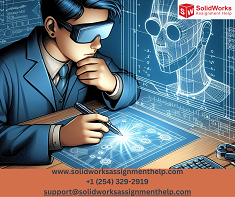Mastering 3D Modeling: Sample Assignments and Expert Solutions
Greetings fellow 3D modeling enthusiasts and seekers of knowledge! Today, we delve into the intricate world of 3D modeling with a set of challenging questions and their expert solutions. Whether you're a student seeking help with your assignments or an enthusiast eager to sharpen your skills, you're in the right place.
Question 1: Sculpting a Detailed 3D Character
You've been tasked with sculpting a detailed 3D character model for a video game. The character is a humanoid robot with intricate mechanical features. Your task is to create a high-resolution sculpt in ZBrush, paying attention to details like joints, pistons, and surface textures. Additionally, optimize the model for animation and ensure it can be rigged efficiently.
Solution:
To tackle this assignment effectively, let's break it down into key steps:
Reference Gathering: Begin by collecting reference images of humanoid robots, focusing on mechanical details and articulation. This will serve as a guide throughout the sculpting process.
Base Mesh Creation: Start with a simple base mesh in ZBrush, ensuring it has sufficient topology for sculpting details. Use ZSpheres or traditional polygon modeling techniques to create the base.
Primary Forms: Block out the primary forms of the character, focusing on establishing the overall silhouette and proportions. Pay attention to anatomical correctness and mechanical design elements.
Detail Sculpting: Gradually increase the resolution of the mesh and start adding finer details using sculpting brushes like Dam Standard, Clay Buildup, and Orb Cracks. Concentrate on intricate mechanical features such as gears, hydraulics, and paneling.
Surface Texture: Use alphas and custom brushes to create surface textures that mimic metal, rubber, or any other materials present on the robot. Experiment with different materials and shaders to achieve realistic results.
Optimization for Animation: While adding details, keep in mind the need for efficient rigging and animation. Avoid excessively dense geometry in areas that won't be visible or deforming significantly during animation.
Topology Retopology: If necessary, perform topology retopology to ensure clean, efficient topology conducive to animation. Tools like ZRemesher can be utilized for this purpose.
Final Touches: Once satisfied with the sculpt, perform final tweaks and polish to enhance the overall quality. Pay attention to areas of intersection and ensure smooth transitions between different parts of the model.
Presentation: Render the final model using ZBrush's built-in rendering capabilities or export it to a rendering software like KeyShot for presentation. Experiment with lighting setups and materials to showcase the character in the best possible light.
By following these steps diligently and staying true to the design brief, you'll be able to sculpt a captivating 3D character ready for integration into a video game environment.
Question 2: Architectural Visualization
You've been commissioned to create a photorealistic architectural visualization of a modern house interior. The scene should include furniture, lighting fixtures, and other interior elements, with a focus on realism and attention to detail. Your task is to model and texture the scene in Autodesk 3ds Max, ensuring accurate proportions and realistic material shaders.
Solution:
Creating a photorealistic architectural visualization requires a meticulous approach and attention to detail. Let's outline the steps to achieve this:
Reference Gathering: Begin by gathering reference images of modern house interiors similar to the one you're tasked with visualizing. Pay attention to architectural details, furniture styles, and lighting setups.
Scene Setup: Set up the scene in Autodesk 3ds Max, including the floor plan, walls, and ceiling. Ensure accurate proportions and scale by referencing architectural drawings or measurements.
Modeling Furniture and Props: Model the furniture pieces and interior props using a combination of primitive shapes and polygon modeling techniques. Focus on clean topology and accurate proportions for realistic results.
Material Creation: Create realistic material shaders for the various surfaces in the scene, including wood flooring, fabric upholstery, and glass windows. Utilize 3ds Max's material editor to adjust parameters such as reflectivity, glossiness, and texture mapping.
Lighting Setup: Set up realistic lighting using a combination of natural and artificial light sources. Experiment with different lighting setups to achieve the desired mood and ambiance for the scene.
Texture Mapping: Apply textures to the model surfaces using high-quality texture maps and UV mapping techniques. Pay attention to texture resolution and mapping distortion to ensure a seamless appearance.
Detailing and Decoration: Add small details and decorative elements to enhance the realism of the scene, such as wall art, potted plants, and decorative lighting fixtures.
Rendering: Render the scene using 3ds Max's built-in rendering engine or external renderers like V-Ray or Corona Renderer. Experiment with camera angles and composition to capture the scene in its best light.
Post-Processing: Perform post-processing effects such as color correction, depth of field, and lens effects to enhance the final rendered image. Use software like Adobe Photoshop or After Effects for additional refinement.
By following these steps and exercising creativity and attention to detail, you'll be able to create a stunning photorealistic architectural visualization that meets the client's expectations.
In conclusion, mastering 3D modeling requires a combination of technical skill, creativity, and attention to detail. Whether you're sculpting intricate characters or visualizing architectural spaces, the key lies in understanding the fundamentals and applying them creatively to achieve your desired results. Remember, practice makes perfect, so don't hesitate to experiment and push the boundaries of your skills. Happy modeling!
visit: https://www.solidworksassignmenthelp.com/3d-modeling-assignment-help/
That concludes our exploration of challenging 3D modeling assignments and their expert solutions. If you're seeking further assistance or guidance with your 3D modeling endeavors, don't hesitate to reach out to us at solidworksassignmenthelp.com. Our team of experienced professionals is here to help you succeed. Until next time, happy modeling!


